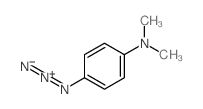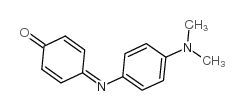p-Dimethylaminoaniline dihydrochloride

p-Dimethylaminoaniline dihydrochloride structure
|
Common Name | p-Dimethylaminoaniline dihydrochloride | ||
|---|---|---|---|---|
| CAS Number | 536-46-9 | Molecular Weight | 209.116 | |
| Density | 0.94g/cm3 | Boiling Point | 211.6ºC at 760mmHg | |
| Molecular Formula | C8H14Cl2N2 | Melting Point | 222 °C (dec.)(lit.) | |
| MSDS | Chinese USA | Flash Point | 84.2ºC | |
| Symbol |

GHS06 |
Signal Word | Danger | |
Use of p-Dimethylaminoaniline dihydrochlorideN,N-Dimethyl-p-phenylenediamine dihydrochloride is a biochemical reagent that can be used as a biological material or organic compound for life science related research. |
| Name | n,n-dimethyl-p-phenylenediamine monohydrochloride |
|---|---|
| Synonym | More Synonyms |
| Description | N,N-Dimethyl-p-phenylenediamine dihydrochloride is a biochemical reagent that can be used as a biological material or organic compound for life science related research. |
|---|---|
| Related Catalog |
| Density | 0.94g/cm3 |
|---|---|
| Boiling Point | 211.6ºC at 760mmHg |
| Melting Point | 222 °C (dec.)(lit.) |
| Molecular Formula | C8H14Cl2N2 |
| Molecular Weight | 209.116 |
| Flash Point | 84.2ºC |
| Exact Mass | 208.053406 |
| PSA | 29.26000 |
| LogP | 3.52000 |
| Storage condition | −20°C |
Synonym:USAF EK-742 Section 2 - COMPOSITION, INFORMATION ON INGREDIENTS
Risk Phrases: 23/24/25 Section 3 - HAZARDS IDENTIFICATION EMERGENCY OVERVIEW
Toxic by inhalation, in contact with skin and if swallowed.Hygroscopic (absorbs moisture from the air).Light sensitive.The toxicological properties of this material have not been fully investigated. Potential Health Effects Eye: May cause eye irritation. The toxicological properties of this material have not been fully investigated. Skin: May cause skin irritation. The toxicological properties of this material have not been fully investigated. Ingestion: May cause digestive tract disturbances. The toxicological properties of this substance have not been fully investigated. Inhalation: May cause respiratory tract irritation. The toxicological properties of this substance have not been fully investigated. Chronic: No information found. Section 4 - FIRST AID MEASURES Eyes: Flush eyes with plenty of water for at least 15 minutes, occasionally lifting the upper and lower eyelids. Get medical aid immediately. Skin: Get medical aid immediately. Flush skin with plenty of water for at least 15 minutes while removing contaminated clothing and shoes. Wash clothing before reuse. Ingestion: If victim is conscious and alert, give 2-4 cupfuls of milk or water. Never give anything by mouth to an unconscious person. Get medical aid immediately. Inhalation: Get medical aid immediately. Remove from exposure and move to fresh air immediately. If not breathing, give artificial respiration. If breathing is difficult, give oxygen. Notes to Physician: Section 5 - FIRE FIGHTING MEASURES General Information: As in any fire, wear a self-contained breathing apparatus in pressure-demand, MSHA/NIOSH (approved or equivalent), and full protective gear. Extinguishing Media: Use agent most appropriate to extinguish fire. Do NOT get water inside containers. Use water spray, dry chemical, carbon dioxide, or appropriate foam. Section 6 - ACCIDENTAL RELEASE MEASURES General Information: Use proper personal protective equipment as indicated in Section 8. Spills/Leaks: Sweep up or absorb material, then place into a suitable clean, dry, closed container for disposal. Avoid generating dusty conditions. Provide ventilation. Do not get water inside containers. Section 7 - HANDLING and STORAGE Handling: Wash thoroughly after handling. Wash hands before eating. Use only in a well-ventilated area. Avoid contact with eyes, skin, and clothing. Avoid ingestion and inhalation. Store protected from light. Do not allow contact with water. Wash clothing before reuse. Storage: Store in a tightly closed container. Store in a cool, dry, well-ventilated area away from incompatible substances. Store protected from moisture. Store protected from light. Section 8 - EXPOSURE CONTROLS, PERSONAL PROTECTION Engineering Controls: Use adequate ventilation to keep airborne concentrations low. Exposure Limits CAS# 536-46-9: Personal Protective Equipment Eyes: Wear appropriate protective eyeglasses or chemical safety goggles as described by OSHA's eye and face protection regulations in 29 CFR 1910.133 or European Standard EN166. Skin: Wear appropriate protective gloves to prevent skin exposure. Clothing: Wear appropriate protective clothing to prevent skin exposure. Respirators: Follow the OSHA respirator regulations found in 29 CFR 1910.134 or European Standard EN 149. Use a NIOSH/MSHA or European Standard EN 149 approved respirator if exposure limits are exceeded or if irritation or other symptoms are experienced. Section 9 - PHYSICAL AND CHEMICAL PROPERTIES Physical State: Chunks Color: off-white Odor: Not available. pH: Not available. Vapor Pressure: Not available. Viscosity: Not available. Boiling Point: Not available. Freezing/Melting Point: 222 deg C Autoignition Temperature: Not available. Flash Point: Not available. Explosion Limits, lower: N/A Explosion Limits, upper: N/A Decomposition Temperature: Solubility in water: freely soluble Specific Gravity/Density: Molecular Formula: C8H12N2.2HCl Molecular Weight: 209.12 Section 10 - STABILITY AND REACTIVITY Chemical Stability: Stable under normal temperatures and pressures. Conditions to Avoid: Incompatible materials, light, moisture. Incompatibilities with Other Materials: Strong oxidizing agents, acids, acid chlorides, acid anhydrides. Hazardous Decomposition Products: Hydrogen chloride, nitrogen oxides, carbon monoxide, irritating and toxic fumes and gases, carbon dioxide. Hazardous Polymerization: Has not been reported Section 11 - TOXICOLOGICAL INFORMATION RTECS#: CAS# 536-46-9: ST1300000 LD50/LC50: Not available. Carcinogenicity: N,N-Dimethyl-p-Phenylenediamine Dihydrochloride - Not listed by ACGIH, IARC, or NTP. Other: See actual entry in RTECS for complete information. Section 12 - ECOLOGICAL INFORMATION Section 13 - DISPOSAL CONSIDERATIONS Dispose of in a manner consistent with federal, state, and local regulations. Section 14 - TRANSPORT INFORMATION IATA Shipping Name: TOXIC SOLID, ORGANIC, N.O.S.* Hazard Class: 6.1 UN Number: 2811 Packing Group: II IMO Shipping Name: TOXIC SOLID, ORGANIC, N.O.S. Hazard Class: 6.1 UN Number: 2811 Packing Group: II RID/ADR Shipping Name: TOXIC SOLID, ORGANIC, N.O.S. Hazard Class: 6.1 UN Number: 2811 Packing group: II Section 15 - REGULATORY INFORMATION European/International Regulations European Labeling in Accordance with EC Directives Hazard Symbols: T Risk Phrases: R 23/24/25 Toxic by inhalation, in contact with skin and if swallowed. Safety Phrases: S 28A After contact with skin, wash immediately with plenty of water. S 45 In case of accident or if you feel unwell, seek medical advice immediately (show the label where possible). WGK (Water Danger/Protection) CAS# 536-46-9: No information available. Canada CAS# 536-46-9 is listed on Canada's DSL List. CAS# 536-46-9 is not listed on Canada's Ingredient Disclosure List. US FEDERAL TSCA CAS# 536-46-9 is listed on the TSCA inventory. SECTION 16 - ADDITIONAL INFORMATION N/A |
CHEMICAL IDENTIFICATION
HEALTH HAZARD DATAACUTE TOXICITY DATA
|
| Symbol |

GHS06 |
|---|---|
| Signal Word | Danger |
| Hazard Statements | H300-H311 + H331-H319 |
| Precautionary Statements | P261-P264-P280-P301 + P310-P305 + P351 + P338-P311 |
| Personal Protective Equipment | Eyeshields;Faceshields;Gloves;type P2 (EN 143) respirator cartridges |
| Hazard Codes | T:Toxic; |
| Risk Phrases | R23/24/25 |
| Safety Phrases | S36/37-S45 |
| RIDADR | UN 2811 6.1/PG 2 |
| WGK Germany | 3 |
| RTECS | ST1750000 |
| Packaging Group | III |
| Hazard Class | 6.1 |
| HS Code | 2921590090 |
| HS Code | 2921590090 |
|---|---|
| Summary | 2921590090. other aromatic polyamines and their derivatives; salts thereof. VAT:17.0%. Tax rebate rate:13.0%. . MFN tariff:6.5%. General tariff:30.0% |
|
A colourimetric sensor for the simultaneous determination of oxidative status and antioxidant activity on the same membrane: N,N-dimethyl-p-phenylene diamine (DMPD) on Nafion.
Anal. Chim. Acta 865 , 60-70, (2015) A colourimetric sensor capable of simultaneously measuring oxidative status (OS) in terms of the hazard produced by reactive oxygen species (ROS) and antioxidant activity (AOA) in regard to ROS-scaven... |
|
|
Purification and characterization of a novel laccase from the mushroom Pleurotus nebrodensis.
Acta Biochim. Pol. 59(3) , 407-12, (2012) A novel laccase with a molecular mass of 64 kDa and the N-terminal sequence AIGPDDTINF was isolated from fresh fruiting bodies of the mushroom Pleurotus nebrodensis. The purification protocol comprise... |
|
|
Heterogeneity of sulfated microdomains within basement membranes of pulmonary airway epithelium.
Am. J. Respir. Cell. Mol. Biol. 10(4) , 462-9, (1994) The purpose of this study was to determine whether the cytochemically defined distribution of sulfated macromolecules is significantly different in microdomains of basement membranes (BMs) associated ... |
| DIMETHYLAMINOANILINE |
| EINECS 218-146-0 |
| 4-Amino-N,N-dimethylaniline dihydrochloride |
| DMPPDA.2HCl |
| N,NDimethylPPhenylenediamineDihclGr |
| N,N-Dimethyl-p-phenylenediami |
| 1,4-benzenediamine, N,N-dimethyl-, dihydrochloride |
| N,N-Dimethylbenzene-1,4-diamine dihydrochloride |
| DMPPDA 2HCL |
| NNDIMETHYLPARAPHENYLENEDIAMINE |
| N,N-dimethyl-1,4-phenylenendiamine dihydrochloride |
| N,N-DIMETHYL-P-PHENYLENEDIAMINE DI HCL |
| 4-Dimethylaminoaniline Dihydrochloride |
| N,N-Dimethyl-p-phenylenediamine dihydrochloride |
| N,N'-(dimethylamino)-1,4-phenylenediamine dihydrochloride |
| MFCD00012990 |
| usafek-7423 |
| N,N-DIMETHYL-P-PHENYLENEDIAMINE 2HCL |
| N,N,-dimethyl-p-phenylenediamine dihydrochloride |
| N,N-Dimethyl-p-phenylenediammonium Dichloride |
| 1,4-(N,N-dimethyl)phenylenediamine dihydrochloride |
| N,N-dimethyl-1,4-phenylenediamine dihydrochloride |
| DMPPDA2HC1 |
| p-Dimethylaminoaniline dihydrochloride |
| DMPD 2HCL |
| 1,4-Benzenediamine, N,N-dimethyl-, hydrochloride (1:2) |
| N,N-Dimethyl-1,4-benzenediamine dihydrochloride |
 CAS#:225091-66-7
CAS#:225091-66-7 CAS#:92-31-9
CAS#:92-31-9 CAS#:18523-44-9
CAS#:18523-44-9 CAS#:58402-54-3
CAS#:58402-54-3 CAS#:2150-58-5
CAS#:2150-58-5![1-[4-(dimethylamino)phenyl]-2-thiourea structure](https://image.chemsrc.com/caspic/062/22283-43-8.png) CAS#:22283-43-8
CAS#:22283-43-8 CAS#:3009-34-5
CAS#:3009-34-5
